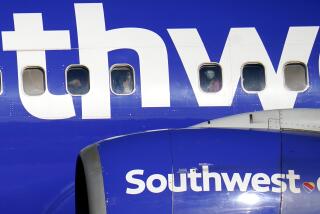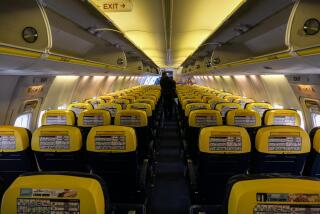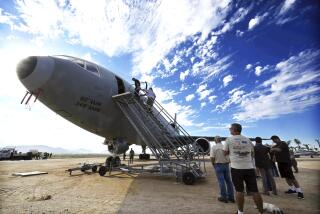New Rx for In-Flight Illnesses : Expanded First-Aid Kits Required Aboard Planes
- Share via
The Pan Am flight to San Francisco was about an hour out of London when Dr. Richard Selby, a Santa Ana neurologist, heard a flight attendant ask if there was a physician on board.
A man in his 60s had collapsed, unconscious, in the aisle six rows behind Selby.
Within seconds, Selby, a British nurse and an emergency room doctor from San Jose, were at the side of the stricken passenger. In examining the cold and clammy man, Selby detected a faint pulse.
Seizure or Coma
“His pupils were reactive, which would indicate to me his brain was still functioning,” Selby said. “At that point I determined he either had a seizure or was in a diabetic coma.”
Looking through the man’s belongings for clues, Selby found insulin and a diabetic test kit.
Selby got a drop of blood from the man by sticking him with one of his syringe needles, then applied the drop of blood to a test tape in the kit that measures blood sugar levels by color change.
“We then decided it was a hypoglycemic diabetic coma--his blood sugar had dropped to very low levels,” Selby said. “The problem was we had to get sugar into him.”
First-Aid Kit
It was then that Selby discovered what countless other physicians have learned in in-flight medical emergencies: Beyond a basic first-aid kit, which consists primarily of bandages and ammonia inhalants, U.S. airlines are not equipped to deal with most medical emergencies.
That situation, however, is about to change.
Beginning Aug. 1, a new Federal Aviation Administration ruling will require that all U.S. airlines carrying 30 or more passengers per flight be equipped with an expanded medical kit. This kit, according to the FAA, must contain equipment and supplies for treating such medical emergencies as acute allergic reactions, angina (chest pain due to an insufficient blood supply to the heart), insulin shock and hypoglycemic diabetic coma.
Had Selby had such a kit, presumably he could have treated his in-flight patient almost as effectively as most hospital emergency rooms where, Selby said, “he would have been given 50% glucose and water intravenously, and he would have been awake in minutes.
“But without the i.v., he could die or sustain severe brain damage.”
Improvising Pays Off
In the case of Selby’s flight in March, however, ingeniousness made up for short emergency medical supplies.
“We took Coca-Cola and packages of sugar and one man--a kiwi farmer from Northern California --stood there continuously stirring that solution,” Selby said. “The problem was getting it into the man because he was comatose and not swallowing.”
Selby took the rubber tubing off a stereo earphone set and inserted the tube through the man’s mouth into his stomach. He then forced the liquid down the tube.
“His (the patient’s) blood sugar was zero on the test kit, so we knew he didn’t have much time,” Selby said, adding that he remained in constant touch with the plane’s captain, who was prepared to land in Iceland if necessary.
As it turned out, the plane did not have to divert to Iceland.
“By the second hour he regained consciousness and was talking. . . . The man actually walked off the plane to meet his daughter,” Selby said.
Despite the happy ending, the experience left Selby feeling frustrated and concerned about public safety on board airlines.
Airlines’ Opposition
Over the years, the airline industry has been opposed to carrying more fully equipped medical kits--which would contain surgical instruments, controlled substances and other major medical supplies--on board passenger planes. Such kits, the airlines argue, would not only be expensive but could lead to misuse and potential liability. And, they maintain, cases of passengers becoming seriously ill are extremely rare.
“A noisy airline cabin is not the place to perform an accurate diagnosis,” said Thomas Tripp, manager of technical information for the Air Transport Assn., a trade and service organization for U.S. scheduled airlines.
“We’ve always considered the airlines to be a 500-m.p.h. ambulance . . . that the first course of action should be to divert the airline and put the passengers on the ground,” said Tripp. “Anywhere in the United States, we can put a passenger into the hands of trained emergency personnel within 20 minutes at the most.”
Selby, however, is not the only physician concerned about the lack of emergency medical supplies on board airplanes.
“On all the flights I’ve been on, there usually are other physicians on board,” said Dr. Edward Austin, a Century City pediatric surgeon. “But you feel helpless not having the medications and the instruments” to use in an emergency.
The medical kit, which the airlines will be required to carry in addition to the basic first-aid kit, will include a stethoscope, blood pressure cuff, airways (rubber tubes that go into the mouth or nose to keep the airway open), syringes, dextrose injection (sugar water for raising blood sugar levels), epinephrine and diphenhydramine hcl injection (both are used to treat acute allergic reactions) and nitroglycerin tablets for angina.
As originally proposed by the FAA, the medical kit also would have included scalpels and other surgical supplies, in addition to morphine and other drugs. But those items were deleted because of concerns expressed by both the airlines and the American Medical Assn. over possible misuse and security reasons.
Shortcomings Noted
Although the AMA hails the expanded medical kit as “a great improvement over the currently required first-aid kit,” many doctors believe the new kit falls short.
“It’s a step in the right direction, but it’s certainly not as far as we want it to go,” said Dr. Mitchell Karlan, a Beverly Hills cancer surgeon, who is president of the Los Angeles County Medical Assn.
Karlan maintains that, among other items, the new kits also should contain Ambu bags that assist with respiration, endotracheal tubes that go into the trachea to help a patient breathe, a laryngoscope that permits the endotracheal tube to be inserted, an i.v. solution and a more adequate supplemental oxygen supply--”the two-liter oxygen (tank) they have on board is hardly enough to get a balloon to blow up,” he said.
Karlan, who has been involved in four in-flight cardiac emergencies in which he administered CPR and closed-chest massages, believes the airlines have an obligation to their passengers.
“If they’re going to take the responsibility of transporting American citizens, they’ve also got to take the responsibility of having appropriate equipment and medications available for the most common medical emergencies that can occur on board.”
Con Hitchcock, legal director of the Aviation Consumer Action Project in Washington, which has been lobbying for an expanded medical kit since 1980, agrees.
“We’re pleased the FAA has recognized that there is a problem, but we’re disappointed that the agency did not go further and require additional equipment or drugs,” he said. “Their concerns, I think, are overstated as evidenced by the fact a number of foreign airlines use these type of kits apparently without problems.”
Hitchcock noted that the FAA ruling requires the airlines to report all in-flight medical emergencies for the next two years, which, he said, “might provide additional evidence for strengthening the kits and putting more equipment in if the need is indicated.”
Keeping Records
Previously, airlines have not been required to report in-flight medical emergencies. As a result, there are no precise statistics on how common they are.
FAA spokesman Fred Farrar said, however, that they are “very infrequent.” Farrar said an estimated 21 in-flight deaths occur each year, and about 10% of these might have been prevented if the new medical kit had been on board. Hitchcock said an airline industry lobbying group estimated that 50 to 100 people die in-flight each year.
The FAA ruling requiring the new medical kit does not address liability. Pending are two bills in the House of Representatives and one in the Senate containing good Samaritan clauses, which would relieve physicians and others from liability for treating ill or injured passengers. The Senate approved one bill, authored by Sen. Barry Goldwater (R-Ariz.), in February but it has not been acted on in the House.
The FAA ruling also leaves unanswered the question of who should have access to the expanded medical kits, which will cost about $100 apiece.
Speaking for the FAA, Farrar said, “Our expectation is that flight attendants and flight crew members should not be using the kit. To use the kit would force them to make a diagnosis, which they’re not qualified to do.”
Still, the FAA’s lack of direction on the matter has some flight attendants concerned.
“None of us are trained to give injections and to make that kind of a medical decision,” said Kathleen Pengra, a Western Airlines flight attendant from Fountain Valley. “I think most of us wouldn’t be willing to do it without a lot of training and a lot more money to take the risk of being sued.”
Matt Finucane, director of air safety and health for the 23,000-member national Assn. of Flight Attendants, said, “The flight attendants do not anticipate they will be using the kit--they will turn it over to qualified, properly identified medical personnel.”
Finucane said, however, that even if an airline’s policy is to turn the medical kits over only to properly identified medical personnel, unanswered questions remain.
“I think at some point,” he said, “people may find themselves in an ethical dilemma where, let’s say a carrier says, ‘Give this only to a properly identified doctor,’ and someone says, ‘I’m a doctor, but I have no ID,’ and you have a person who looks like he’s dying on you. What are you going to do?
A Long Debate
“A similar dilemma might be that a carrier says, ‘Give this only to a doctor,’ and someone says, ‘I’m a paramedic, and I’ve worked for 10 years handling cases like this.’ Do you give the kit to the person if you have someone in bad shape?”
But, Finucane said, “It’s better to have some ethical dilemmas than have 50 to 100 people die in flight and no possibility of helping them.”
Pan Am spokesman James Arey said that the debate over “whether or not to have expanded medical kits on board” has been going on through 60 years of commercial aviation.
“Generally speaking,” he said, “while there are one or two airlines that have more elaborate medical kits on board, 95% of the airlines believe the most efficient and best course of action is to land at the nearest point and get the person professional help with professional equipment rather than relying on good Samaritan procedures.”
Janice Northcott, in-flight services safety manager for United Airlines, said United started a test program using advanced medical kits on select over-water flights to Hong Kong and Tokyo in 1982.
But the kits, which included injectable drugs and some surgical instruments, were used infrequency and were never used to save a life, she said.
As for the FAA-mandated medical kit, Northcott said United plans to keep it locked in the cockpit and make it available to properly identified medical professionals.
“You’ve got to really try it,” she said. “The best experience is to get a lot of airlines and see how effective the kits are.”
More to Read
Sign up for Essential California
The most important California stories and recommendations in your inbox every morning.
You may occasionally receive promotional content from the Los Angeles Times.










